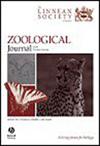Evolutionary history of the Altai grey vole, Microtus obscurus (Rodentia: Cricetidae), reconstructed using modern and ancient genomes
IF 2.8
2区 生物学
Q1 ZOOLOGY
引用次数: 0
Abstract
The Altai grey vole (Microtus obscurus) is a rodent species present in Western Asia, Eastern Europe, and the Near East. The taxonomic relationship of M. obscurus and its sister-species, Microtus arvalis, is a matter of ongoing debate and there is a lack of agreement regarding the date of their divergence. To further understand the evolutionary history of M. obscurus, we generated nuclear and mitochondrial data from five modern and 11 ancient specimens from Eastern Europe and the Near East. We reconstructed a tip-dated phylogeny using a 4.3-kilobase fragment of mitochondrial DNA. We estimated the time to the most recent common ancestor of M. arvalis and M. obscurus to be 130 thousand years ago (kya), correlating with the Eemian interglacial, a period characterized by the reduction of open habitats suitable for microtine species. In the Lesser Caucasus, we recorded a turnover of two lineages probably related to environmental changes at the end of the Pleistocene. Using three published and three newly generated nuclear genomes, we confirmed the general population structure and divergence times inferred from the mtDNA. We reconstructed the demographic history of the Altai grey vole, which revealed contrasting trajectories for the two main lineages.利用现代和古代基因组重建阿尔泰灰田鼠的进化历史,Microtus obscurus(啮齿目:蟋蟀科)
阿尔泰灰田鼠(Microtus obscurus)是一种啮齿类动物,分布于西亚、东欧和近东。关于M. obscurus和它的姊妹种Microtus arvalis的分类学关系,一直是一个争论不休的问题,关于它们分化的时间也缺乏共识。为了进一步了解隐匿m.s oburus的进化史,我们对来自东欧和近东的5个现代和11个古代标本进行了核和线粒体数据分析。我们利用一个4.3千碱基的线粒体DNA片段重建了一个尖端时代的系统发育。我们估计M. arvalis和M. obscurus最近的共同祖先的时间为13万年前(kya),与Eemian间冰期相关,这一时期的特征是适合微藻物种的开放栖息地减少。在小高加索地区,我们记录了两个谱系的更替,这可能与更新世末期的环境变化有关。利用三个已发表的和三个新生成的核基因组,我们证实了从mtDNA推断的总体群体结构和分化时间。我们重建了阿尔泰灰田鼠的人口统计历史,揭示了两个主要谱系的对比轨迹。
本文章由计算机程序翻译,如有差异,请以英文原文为准。
求助全文
约1分钟内获得全文
求助全文
来源期刊
CiteScore
6.50
自引率
10.70%
发文量
116
审稿时长
6-12 weeks
期刊介绍:
The Zoological Journal of the Linnean Society publishes papers on systematic and evolutionary zoology and comparative, functional and other studies where relevant to these areas. Studies of extinct as well as living animals are included. Reviews are also published; these may be invited by the Editorial Board, but uninvited reviews may also be considered. The Zoological Journal also has a wide circulation amongst zoologists and although narrowly specialized papers are not excluded, potential authors should bear that readership in mind.

 求助内容:
求助内容: 应助结果提醒方式:
应助结果提醒方式:


